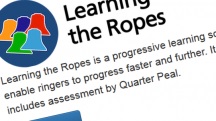Odd one IN
Why is it that some bells are harder to strike well than others? It is probably because they are odd-struck. So, what is odd-struckness? It's ‘a different delay between handstroke and backstroke of the same bell’ (taken from the Ringing World 5/11/2004).
This could happen for a variety of mechanical reasons – rarely are the bells we ring all part of a perfect set! Sometimes the odd-struckness is very pronounced and ringing needs to be adjusted to compensate for this.
The effect of odd-struckness is that you need to leave either bigger or smaller visual gaps. The bell you are ringing could be odd struck at either handstroke or backstroke – or both, and the odd-struckness could mean the bell is either quick or slow at either of the strokes. The situation can be compounded if the bell that you are following is also odd-struck. If you always ring the same bell, you may get used to how you need to ring to strike in the right place. However, when asked to ring a different bell or if visiting a different tower, how can you sort out the odd-struck bells?
Here are some tips:
- Listen to any advice that you are given before you catch hold. This will particularly be the case if the bell is notoriously odd-struck
- Listen out before you ring to see what instructions other people are being given. If someone else is being told continually to “keep their back-strokes in”, then there is clearly an issue and you can learn from this
- Don’t forget that you should be holding up slightly at handstroke on any bell. This is for the handstroke gap. Everyone needs to do this, not just the treble
- Count your place in the row when you are ringing rounds so that you can identify the sound your bell is making
- Are the gaps between your bell and the ones before and after the same? If not, is it because you are ringing too soon or too late? This can be confusing, as you may be leaving a perfectly nice ‘visual’ gap but to overcome the odd-struckness, you have to leave a much bigger gap, or ring almost at the same time of the bell you are following!
- Having identified that you are not striking your bell evenly, you need to identify how to correct this.Is it the same at both strokes? If it is not the same, the bell you are ringing is probably odd-struck. If you find that you need to hold the handstroke up, you will have to make the opposite alteration to your backstroke and vice versa
- Sometimes it is useful to NOT look at the bell you are following for a few blows so that you do not get confused by any potential odd-struckness in that bell. This allows you to concentrate on listening
- It is always fine to ask for advice and help!

Janet Horton, Teacher at the Birmingham School of Bell Ringing